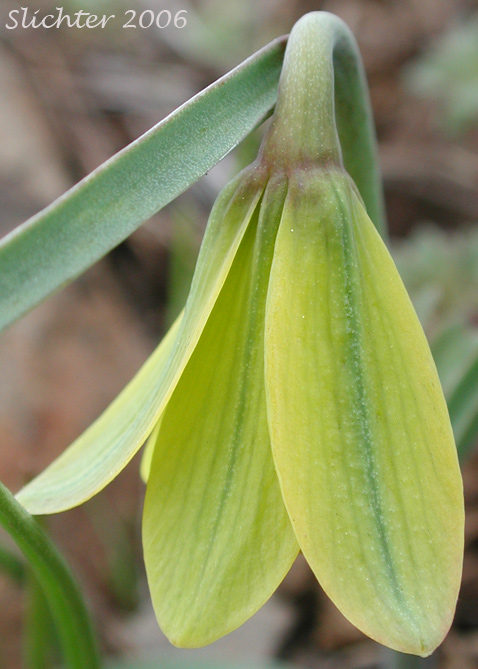[Wildflower bloom in the Southern Washington Cascades: 2006]
[Wildflower Bloom in the Cascade Mts. of Washington: 2005] [Wildflower Bloom in the Cascade Mts. Prior to 2005]The site visited for this page's study is at an approximate elevation of 4100' and is evidently a Washington State DNR rock quarry that is atop the ridge separating Dairy Creek and Cougar Creek. The south-facing slopes are open forest of Ponderosa pine as well as some Oregon white oak with abundant grasses and colorful wildflowers. Uphill, the habitat changes quickly to a dense, dark coniferous forest. On the east side of the rockpit, rocky or gravelly slopes are vernally moist and provide a habitat for small plants normally found at lower elevations and farther to the east. The current snow level is below this ridge, but the access road has recently been plowed. Be aware that the surface of the access road has recently had large diameter gravel (up to 2-4 inches in diameter) laid on its surface, giving it quite a rough ride and endagering tires, at least for low slung passenger vehicles!
 The
photo at right shows a close-up of the new blossom of yellow bells, Fritillaria
pudica on slopes directly below the rock quarry mentioned on this page.......May
6, 2006.
The
photo at right shows a close-up of the new blossom of yellow bells, Fritillaria
pudica on slopes directly below the rock quarry mentioned on this page.......May
6, 2006.
* indicates the wildflower is currently in bloom.
1. Oregon White Oak: Quercus garryana - Plants haven't leafed out yet.
2. Tapertip Onion: Allium accuminatum - Numerous leaves and young plants.
* 3. Glacier Lily: Erythronium grandiflorum - Fairly numerous in deeper soils on south-facing slopes to the west of the rock pit.
* 4. Yellow Bells: Fritillaria pudica - Several dozen seen in bloom at this site.
* 5. Spring Beauty: Claytonia lanceolata - Fairly numerous.
6. Upland Larkspur: Delphinium nuttallianum - Basal leaves only.
* 7. Steer's Head: Dicentra uniflora - Numerous on shallow, south-facing slopes which probably had snow on them a week ago or so.
* 8. Oaks Toothwort: Cardamine nuttallii var. nuttallii - Fairly numerous.
9. Bulblet Prairie Star: Lithophrabma glabrum (formerly L. bulbifera) - Numerous, but still about one week from bloom.
10. Small-flowered Prairie Star: Lithophragma parviflora - Numerous basal leaves seen.
11. Antelope Bitterbrush: Purshia tridentata - Plants cover up to a six foot square area but are at most only a few inches high
12. Bare-stem Desert Parsley: Lomatium nudicaule - Numerous, but small basal leaves only.
* 13. Gorman's Desert Parsley: Lomatium gormanii - Numerous.
14. Nine-leaf Desert Parsley: Lomatium triternatum - Numerous basal leaves.
15. Dwarf Hesperochiron: Hesperochiron pumilus - Fairly common, but basal leaves only at this time.
* 16. Ball-head Waterleaf: Hydrophyllum capitatum var. capitatum - Several seen in bloom.
17. Carey's Balsamroot : Balsamorhiza careyana - A few basal leaves appearing.
18. Western Groundsel: Senecio integerrimus var. exaltatus - Purple-tinged basal leaves fairly numerous at this site.
1. Yellow-rumped Warbler
2. American Robins
3. Nuthatch
4. Numerous Dark-eyed Juncos
5. Drumming grouse in the distance